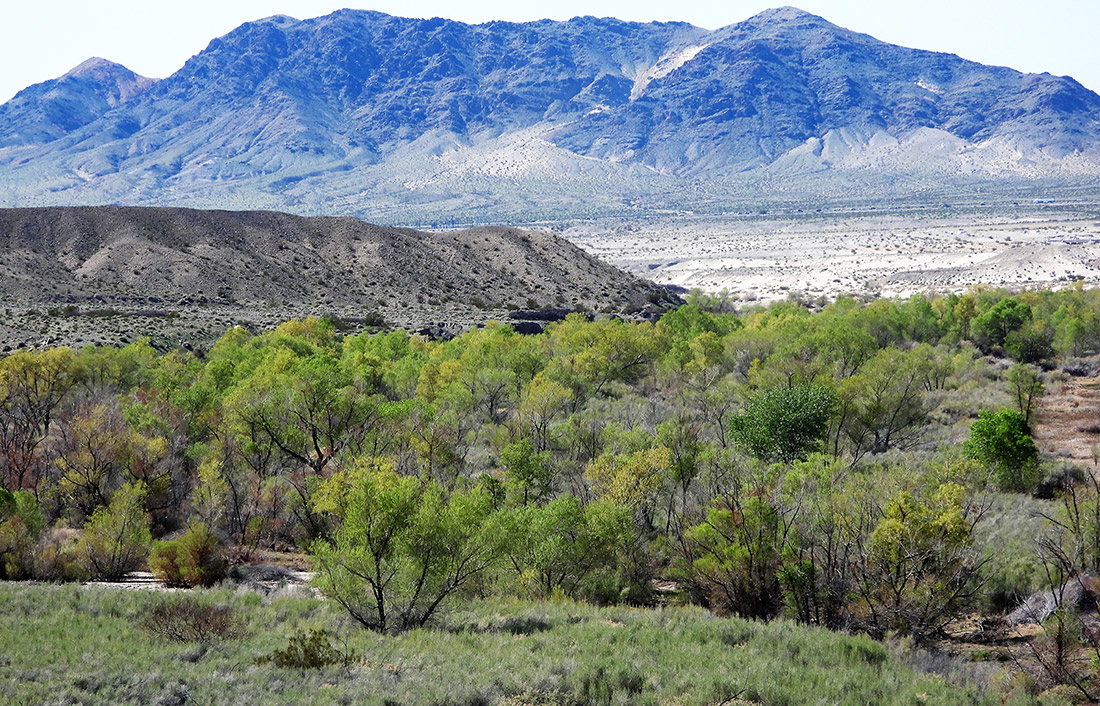By Austin Rempel

INSTEAD OF FLOWING toward the ocean like most rivers, the Mojave River winds east into the heart of the Mojave Desert. For most of its length, it flows underground. Nearly a hundred miles from its origin in the San Bernardino Mountains, the river enters a deep canyon and gradually seeps up from the desert sand. Afton Canyon — located in the heart of the Mojave Trails National Monument — is one of only two places where the river flows continuously above ground, brought to the surface by shallow bedrock.
Remarkably, in a landscape that receives just 4 inches of rain per year, and where summer temperatures routinely exceed 110°F, Afton Canyon supports the growth of tall streamside trees and wet grassy meadows. For centuries the canyon’s water and lush vegetation have made it a magnet for wildlife and migrating birds.
Unfortunately, the 20th century brought many changes to Afton Canyon. The Mojave Forks Dam was built in 1967, cutting off the Mojave River’s seasonal floods that native trees need to propagate, like Fremont cottonwood and black willow. The river’s new flow regime and decades of damage to soils from cattle and off-road vehicle use favored the spread of an exotic tree species called tamarisk, also known as saltcedar.
Originally from Eurasia, tamarisk was intentionally introduced to the canyon in the early 1900s to control erosion around the embankments of the Union Pacific rail line. The plant accumulates salt in its needles and the surrounding soil, which prevents other plants from growing, creating a tamarisk-dominant forest with little biodiversity. Tamarisk also consumes prodigious amounts of water in riparian habitats due to the sheer density of its stands. Free-flowing stretches of the river dwindled in Afton Canyon as the tamarisk multiplied.
In 1990, Tom Egan — a riparian restoration specialist with the Bureau of Land Management (BLM) — was tasked with rescuing the canyon’s native plants and wildlife. Along with reining in cattle grazing and off-road vehicle use, Egan developed a plan to replace the tamarisk with cottonwoods and willows. Egan enlisted the help of fellow staff and the Los Angeles Conservation Corps, a program that employs young at-risk Angelinos to work on conservation and community service projects. Focusing on the western end of the canyon, they burned, cut and chemically treated the tamarisk thickets. When they were finished, nearby sections of the Mojave River began flowing above ground for the first time in years.
Egan and the BLM received one of American Forest’s very first reforestation grants to help with replanting.
Instead of raising seedlings in a nursery, they used willow and cottonwoods’ unique ability to sprout new roots wherever they touch water or moist soil. They harvested live shoots and branches from mature trees upstream of Afton Canyon and planted them deep enough for the young trees to “get their feet wet” and access groundwater.
With support from American Forests, Egan and the LA Conservation Corps workers removed 700 acres of tamarisk and planted more than 10,000 cottonwood and willow poles between 1990 and 2002. Fast forward 20 years and the results are undeniable. Some of the original plantings are nearly 40 feet tall. Migratory birds have returned to the area in force — more than 180 bird species have been spotted at Afton Canyon — and the local Desert Bighorn herd has grown from 30 to more than 300 individuals. The cottonwoods and willows are regenerating naturally, another hallmark of success.
This progress could be at risk without the ongoing stewardship of public servants like Egan and the LA Conservation Corps. Tamarisk requires periodic treatments to keep it at bay. Egan, for his part, continues to advocate for thoughtful management of the area in his role as the California Desert Representative for Defenders of Wildlife.
Austin Rempel writes from Washington, D.C., and is American Forests’ forest conservation manager.